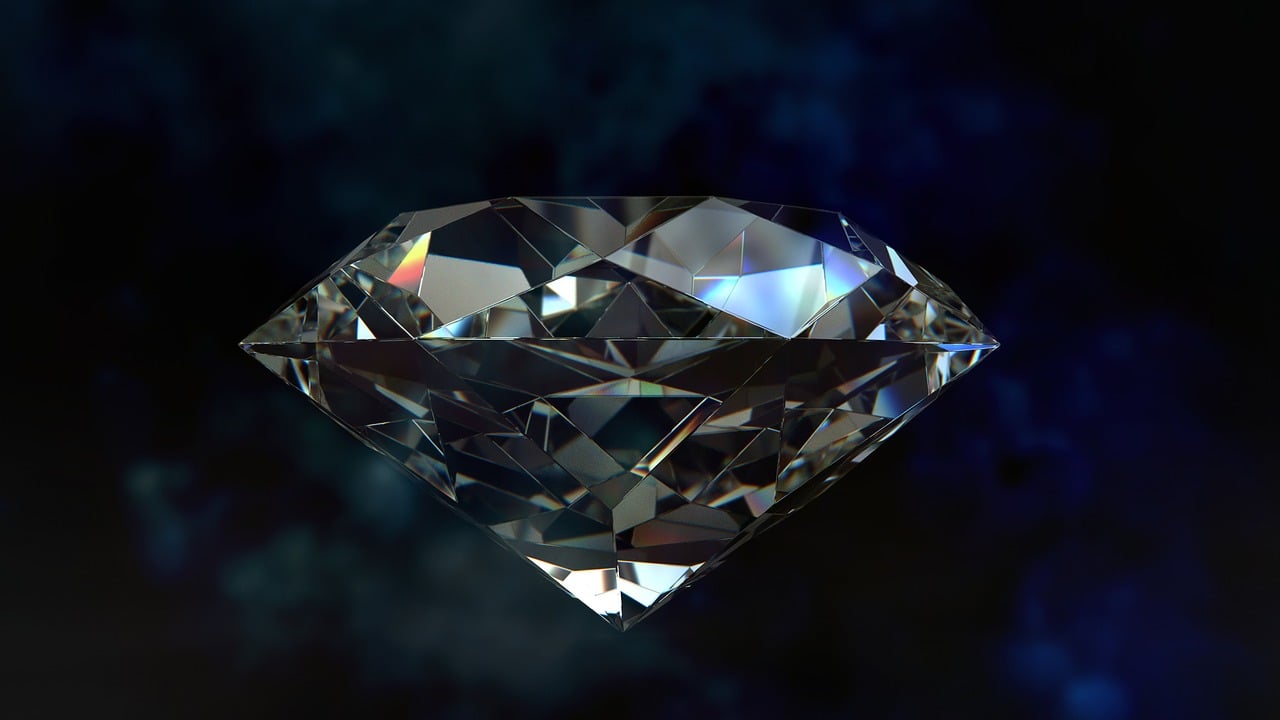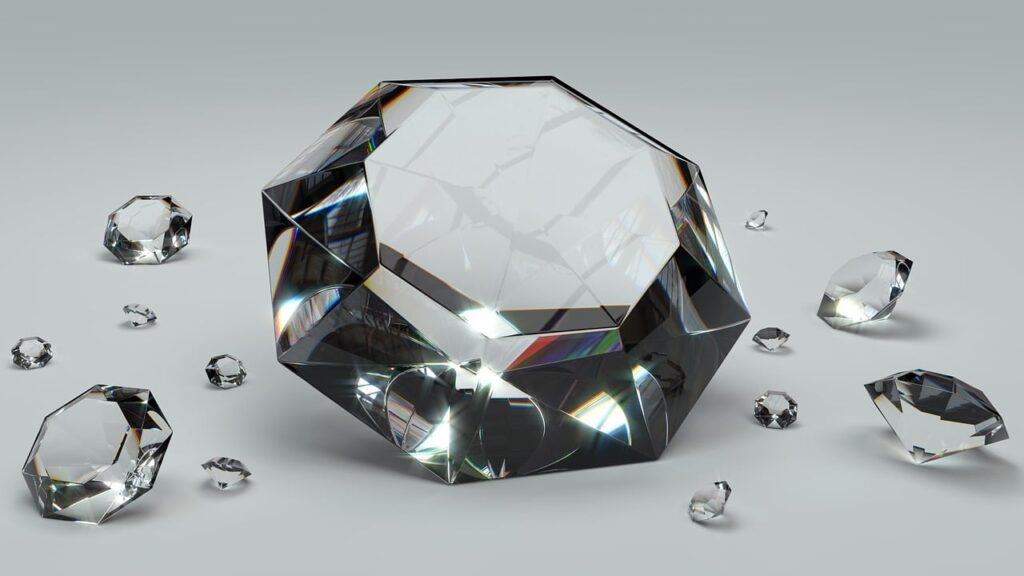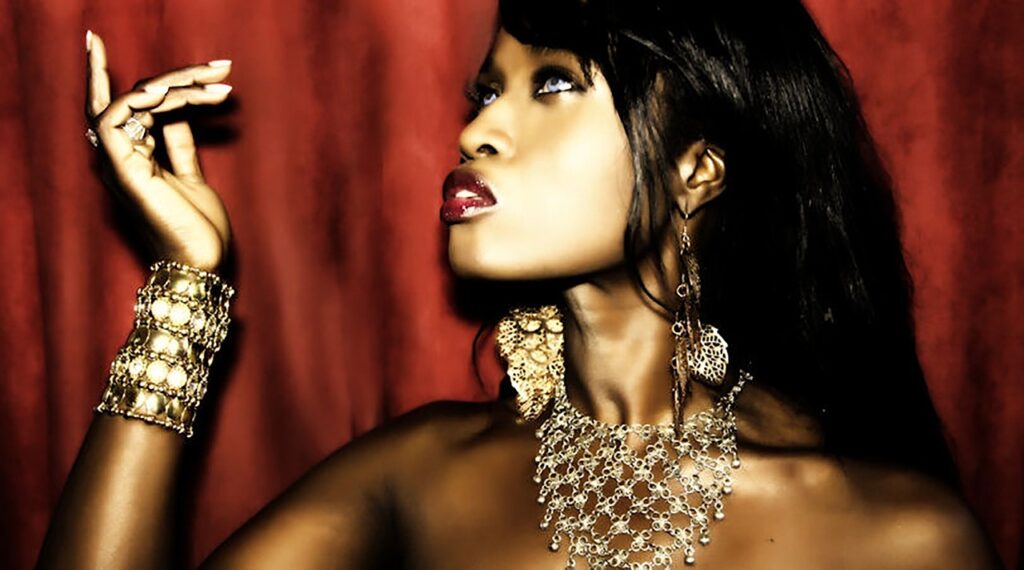
Diamonds have been popular for centuries due to their unique characteristics. They are the hardest natural substance on earth, making them durable and long-lasting. Additionally, their brilliance and fire make them highly desirable for use in jewelry.
Diamonds also hold symbolic value, representing love, commitment, and status. The rarity of some types of diamonds, such as pink or blue diamonds, adds to their allure and exclusivity.
Overall, diamonds have become a timeless and iconic symbol of beauty and luxury.

Factors to consider when choosing a diamond
When choosing a diamond, there are several factors to consider. The first is the 4Cs: carat weight, cut, color, and clarity. These factors determine the quality and value of the diamond. Additionally, it’s important to consider the shape of the diamond, as well as the setting and metal of the ring. The wearer’s personal style and lifestyle should also be taken into account, as certain diamond shapes and settings may be more practical or aesthetically pleasing for some individuals. Finally, it’s important to consider the source of the diamond and ensure it has been ethically and sustainably sourced.
The Four Cs of Diamonds
Cut
Cut is one of the most important factors to consider when choosing a diamond. It refers to the diamond’s proportions, symmetry, and polish, which all affect how the diamond reflects light. A well-cut diamond will have maximum brilliance, fire, and sparkle. The most popular cut is the round brilliant, which has 58 facets and is designed to maximize the diamond’s brilliance. Other popular cuts include princess, cushion, emerald, and pear. When choosing a cut, it’s important to consider personal preference, as well as the diamond’s intended use. For example, a round brilliant cut may be ideal for an engagement ring, while a princess cut may be better suited for a pendant or earrings.
Color
Color is another important factor to consider when choosing a diamond. The color grading scale ranges from D (colorless) to Z (light yellow or brown). The less color a diamond has, the more valuable it is. However, some people prefer diamonds with a slight yellow or brown tint as it can give the stone a warm and unique appearance. It ultimately comes down to personal preference and budget. If you’re looking for a colorless diamond, be prepared to pay a premium price. But if you’re open to a slightly colored diamond, you may be able to find a more affordable option without sacrificing quality.
Clarity
Clarity is another important factor to consider when choosing a diamond. Clarity refers to the presence or absence of inclusions or blemishes in the diamond. Inclusions are internal flaws, while blemishes are external flaws. The clarity of a diamond is graded on a scale from Flawless (no inclusions or blemishes visible under 10x magnification) to Included (inclusions and blemishes visible to the naked eye). A diamond with a higher clarity grade will be more valuable and have a brighter appearance. However, a diamond with a lower clarity grade may still be beautiful and have a unique character. It ultimately comes down to personal preference and budget.
Carat weight
Carat weight is one of the most important factors to consider when choosing a diamond. It refers to the weight of the diamond and is often used to determine its value. The larger the carat weight, the more valuable the diamond is likely to be. However, it’s important to note that carat weight is not the only factor that determines a diamond’s value. The cut, color, and clarity of the diamond are also important considerations. When choosing a diamond, it’s important to find a balance between carat weight and the other factors to ensure that you get the best value for your money.
Different Types of Diamonds
Round Brilliant Cut
The round brilliant cut is the most popular and classic diamond shape. It is designed to maximize the diamond’s brilliance and fire, making it sparkle and shine from every angle. This cut has 58 facets, which are strategically placed to reflect the light and create a stunning display of color and brightness. Round brilliant cut diamonds are versatile and can be set in a variety of styles, from solitaire rings to elaborate halo designs. They are also a great choice for those who want a timeless and elegant look. However, because of their popularity, round brilliant cut diamonds tend to be more expensive than other shapes.
Princess Cut
The princess cut is a popular choice for engagement rings and other jewelry pieces. This cut features a square or rectangular shape with pointed corners and a brilliant cut that enhances the diamond’s sparkle. Princess cut diamonds are versatile and can be set in a variety of styles, from classic solitaires to more elaborate designs. They are also known for their relatively low cost per carat compared to other diamond cuts, making them a great option for those on a budget. However, it’s important to note that the pointed corners of a princess cut diamond can be more susceptible to chipping, so it’s essential to choose a setting that protects the corners.
Emerald Cut
Emerald cut diamonds are rectangular in shape with truncated corners. They are known for their long, clean lines and step-cut facets that create a hall-of-mirrors effect. This cut is perfect for those who want a diamond that is elegant and sophisticated, yet understated. The emerald cut is also a popular choice for those who want a larger diamond, as the elongated shape can make the stone appear larger than it actually is. However, it’s important to note that the emerald cut does not have as much sparkle as other cuts, so it’s important to choose a high-quality diamond to ensure maximum brilliance.
Asscher Cut
The Asscher cut is a square-shaped diamond with cropped corners and a stepped cut that creates a mesmerizing optical illusion. This cut was first introduced in the early 1900s and has since become a popular choice for engagement rings. The Asscher cut diamond has a unique vintage appeal and is often set in a simple solitaire setting to showcase its beauty. This cut is perfect for those who want a diamond that stands out from the traditional round brilliant cut. However, it is important to note that the Asscher cut diamond has a higher price point due to its intricate cut and rarity.
Cushion Cut
Cushion cut diamonds are a popular choice for those who want a vintage or antique look. This cut has been around for over 200 years and was originally called the “old mine cut.” It has a square or rectangular shape with rounded corners and larger facets, which gives it a soft and romantic appearance. Cushion cut diamonds can also come in a variety of ratios, from square to elongated, allowing for customization to fit personal preferences. This cut is ideal for those who want a classic look with a modern twist.
Oval Cut
The oval cut diamond is a popular choice for those who want a unique and elegant look. This cut is similar to the round brilliant cut, but elongated in shape. The oval cut diamond has a larger surface area than a round diamond of the same carat weight, making it appear larger. It also has the added benefit of making fingers appear longer and slimmer. The oval cut diamond is a great choice for those who want a classic look with a modern twist. It is also a great choice for those who want a diamond that is versatile and can be set in a variety of styles.
Pear Cut
The pear cut diamond is a unique and elegant choice for those who want something a little different from the traditional round or princess cut. This cut features a teardrop shape with a rounded end and a pointed end, giving it a beautiful and distinctive look. The pear cut is also known for its ability to create the illusion of longer, more slender fingers when worn as a ring. When choosing a pear cut diamond, it’s important to look for a stone with good symmetry and a well-defined point. This cut is also prone to bow-tie effect, so be sure to examine the stone carefully to ensure that it has good light performance.
Marquise Cut
The marquise cut is a diamond shape that is elongated with pointed ends. It is also known as the “navette” cut, which means “little boat” in French. This cut is perfect for those who want a diamond that looks larger than its carat weight. The marquise cut also has a unique vintage feel that makes it a popular choice for engagement rings. However, it is important to note that the pointed ends of the marquise cut can be vulnerable to chipping, so it is important to choose a setting that protects the diamond.
Heart Cut
The heart cut diamond is a romantic and unique choice for an engagement ring. This cut is essentially a pear-shaped diamond with a cleft at the top, forming a heart shape. The heart cut requires a skilled diamond cutter to ensure that both halves of the heart are symmetrical. This cut is perfect for those who want a diamond that symbolizes love and commitment. However, it is important to note that the heart cut can be more expensive than other cuts due to the skill required to create it.
Radiant Cut
The radiant cut is a rectangular or square-shaped diamond with trimmed corners and 70 facets that reflect light brilliantly. This cut is perfect for those who want a diamond that combines the elegance of an emerald cut with the brilliance of a round cut. The radiant cut is versatile and can be set in a variety of styles, from classic solitaires to more elaborate designs. It is also a popular choice for engagement rings as it offers a unique and modern look. However, due to its complex cut, the radiant cut requires a higher level of skill and precision during the cutting process, making it slightly more expensive than other diamond cuts.
Factors to Consider When Choosing a Diamond
Personal preference
Personal preference plays a significant role in choosing the right diamond. Some people prefer the classic and timeless look of a round brilliant diamond, while others may prefer the unique and modern look of a fancy-shaped diamond such as a princess or cushion cut. Additionally, some individuals may prefer a diamond with a higher clarity grade, while others may prioritize a larger carat weight. Ultimately, it is important to choose a diamond that speaks to your personal style and preferences, as it is a symbol of your love and commitment.
Budget
Budget is an important consideration when choosing a diamond. If you are on a tight budget, you may want to consider a diamond with a lower carat weight or a lower color and clarity grade. However, keep in mind that the cut of the diamond is also important as it affects the diamond’s overall appearance and sparkle. You may also want to consider alternative options such as lab-grown diamonds or diamond simulants which can offer a similar look at a lower cost. Ultimately, it is important to find a diamond that fits within your budget while still meeting your desired specifications and preferences.
Purpose
Purpose: The purpose of buying a diamond can vary from person to person. Some may be looking for an engagement ring or wedding band, while others may want a diamond for a special occasion or as an investment. It’s important to consider your purpose before choosing a diamond, as different types of diamonds are better suited for different purposes. For example, if you’re looking for an engagement ring, you may want to choose a diamond with a high clarity and color grade, while if you’re buying a diamond for investment purposes, you may want to focus on diamonds with a high carat weight and rarity.
Certification
Certification is an important aspect to consider when purchasing a diamond. A certified diamond has been evaluated and graded by a reputable gemological laboratory, ensuring that it meets certain standards of quality and authenticity. The most well-known and respected certification organizations include the Gemological Institute of America (GIA), the American Gem Society (AGS), and the International Gemological Institute (IGI). It is recommended to choose a diamond that has been certified by one of these organizations to ensure that you are getting a high-quality and genuine diamond. Additionally, having a certification can also increase the resale value of the diamond in the future.
Conclusion
Summary of the different types of diamonds
In summary, there are several types of diamonds to choose from when shopping for jewelry. Natural diamonds are the most common and come in a range of colors and clarities. Lab-grown diamonds are a more affordable and environmentally friendly option, while synthetic diamonds are created in a lab to mimic the look of a natural diamond. Finally, fancy colored diamonds are rare and highly sought after for their unique hues. Ultimately, the type of diamond you choose will depend on your personal preferences and budget.
Final thoughts on choosing the right diamond
In the end, choosing the right diamond comes down to personal preference and budget. It’s important to do your research and understand the different characteristics that affect a diamond’s quality and value. Consider factors such as cut, color, clarity, and carat weight, and prioritize which ones are most important to you. Don’t be afraid to ask questions and seek advice from a reputable jeweler. Remember, a diamond is a significant investment, so take your time and choose wisely.
Next Steps
Next Steps: Now that you know about the different types of diamonds, it’s time to start shopping for your perfect piece of jewelry. At iced-out-jewelry.com, we offer a wide variety of diamond jewelry options to suit any style and budget. Whether you’re looking for an engagement ring, a statement necklace, or a pair of earrings, we’ve got you covered. Visit our website today to browse our selection and find the diamond jewelry that speaks to you. Don’t wait, start shopping now and add some sparkle to your life!


